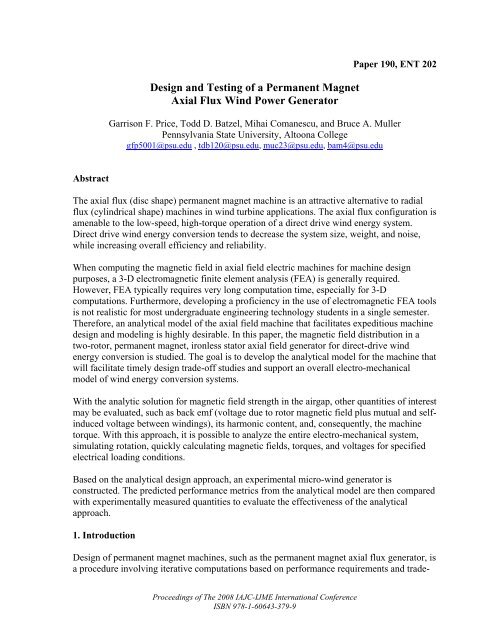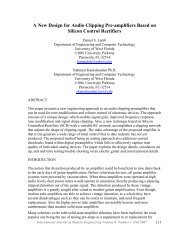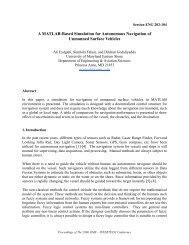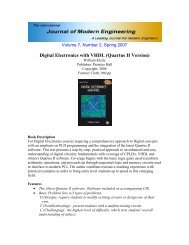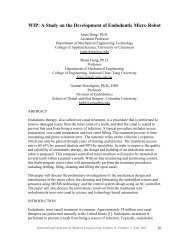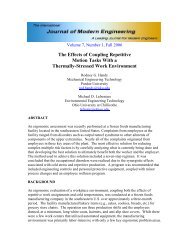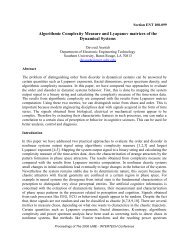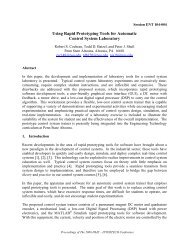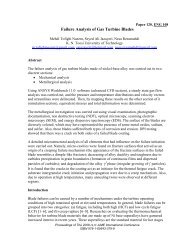Design and Testing of a Permanent Magnet Axial Flux Wind ... - IJME
Design and Testing of a Permanent Magnet Axial Flux Wind ... - IJME
Design and Testing of a Permanent Magnet Axial Flux Wind ... - IJME
Create successful ePaper yourself
Turn your PDF publications into a flip-book with our unique Google optimized e-Paper software.
Abstract<br />
<strong>Design</strong> <strong>and</strong> <strong>Testing</strong> <strong>of</strong> a <strong>Permanent</strong> <strong>Magnet</strong><br />
<strong>Axial</strong> <strong>Flux</strong> <strong>Wind</strong> Power Generator<br />
Proceedings <strong>of</strong> The 2008 IAJC-<strong>IJME</strong> International Conference<br />
ISBN 978-1-60643-379-9<br />
Paper 190, ENT 202<br />
Garrison F. Price, Todd D. Batzel, Mihai Comanescu, <strong>and</strong> Bruce A. Muller<br />
Pennsylvania State University, Altoona College<br />
gfp5001@psu.edu , tdb120@psu.edu, muc23@psu.edu, bam4@psu.edu<br />
The axial flux (disc shape) permanent magnet machine is an attractive alternative to radial<br />
flux (cylindrical shape) machines in wind turbine applications. The axial flux configuration is<br />
amenable to the low-speed, high-torque operation <strong>of</strong> a direct drive wind energy system.<br />
Direct drive wind energy conversion tends to decrease the system size, weight, <strong>and</strong> noise,<br />
while increasing overall efficiency <strong>and</strong> reliability.<br />
When computing the magnetic field in axial field electric machines for machine design<br />
purposes, a 3-D electromagnetic finite element analysis (FEA) is generally required.<br />
However, FEA typically requires very long computation time, especially for 3-D<br />
computations. Furthermore, developing a pr<strong>of</strong>iciency in the use <strong>of</strong> electromagnetic FEA tools<br />
is not realistic for most undergraduate engineering technology students in a single semester.<br />
Therefore, an analytical model <strong>of</strong> the axial field machine that facilitates expeditious machine<br />
design <strong>and</strong> modeling is highly desirable. In this paper, the magnetic field distribution in a<br />
two-rotor, permanent magnet, ironless stator axial field generator for direct-drive wind<br />
energy conversion is studied. The goal is to develop the analytical model for the machine that<br />
will facilitate timely design trade-<strong>of</strong>f studies <strong>and</strong> support an overall electro-mechanical<br />
model <strong>of</strong> wind energy conversion systems.<br />
With the analytic solution for magnetic field strength in the airgap, other quantities <strong>of</strong> interest<br />
may be evaluated, such as back emf (voltage due to rotor magnetic field plus mutual <strong>and</strong> selfinduced<br />
voltage between windings), its harmonic content, <strong>and</strong>, consequently, the machine<br />
torque. With this approach, it is possible to analyze the entire electro-mechanical system,<br />
simulating rotation, quickly calculating magnetic fields, torques, <strong>and</strong> voltages for specified<br />
electrical loading conditions.<br />
Based on the analytical design approach, an experimental micro-wind generator is<br />
constructed. The predicted performance metrics from the analytical model are then compared<br />
with experimentally measured quantities to evaluate the effectiveness <strong>of</strong> the analytical<br />
approach.<br />
1. Introduction<br />
<strong>Design</strong> <strong>of</strong> permanent magnet machines, such as the permanent magnet axial flux generator, is<br />
a procedure involving iterative computations based on performance requirements <strong>and</strong> trade-
<strong>of</strong>fs. Typically, empirical relations or simplified models are used in the early stages <strong>of</strong> the<br />
design, followed by finite element analysis (FEA) in the later stages. In either case,<br />
calculation <strong>of</strong> the airgap magnetic field is <strong>of</strong> utmost importance because it is required for the<br />
calculation <strong>of</strong> performance metrics, such as torque constant, torque ripple, back emf constant,<br />
<strong>and</strong> back emf waveshape.<br />
Calculation <strong>of</strong> the airgap magnetic field using FEA is quite time consuming, especially for an<br />
axial flux permanent magnet machine, since 3-D FEA is generally required. As a result,<br />
analytical methods to obtain magnetic field solutions have been presented in the literature for<br />
permanent magnet synchronous machines <strong>of</strong> radial flux [1, 2], linear [3, 4], <strong>and</strong> axial flux<br />
configuration [5, 6, 7]. However, solutions proposed for axial flux machines [8, 9, 10] use a<br />
mean radius approach, which limits the accuracy <strong>of</strong> the solution for machines whose relative<br />
magnet width or stator coil width is a function <strong>of</strong> stator radius.<br />
In this paper, the magnetic field distribution in a two-rotor, permanent magnet, ironless stator<br />
axial field generator for direct-drive wind energy conversion is studied. The goal is to<br />
develop the analytical model for the machine that will facilitate timely design trade-<strong>of</strong>f<br />
studies <strong>and</strong> support an overall electro-mechanical model <strong>of</strong> energy conversion system. The<br />
model will also consider machine designs where magnet <strong>and</strong> coil width relative to the pole<br />
pitch varies with the machine radius. Analytical results will be validated through a<br />
combination <strong>of</strong> finite element analysis (FEA) <strong>and</strong> a series <strong>of</strong> experiments to demonstrate the<br />
usefulness <strong>of</strong> the proposed method.<br />
2. <strong>Permanent</strong> <strong>Magnet</strong> <strong>Axial</strong> <strong>Flux</strong> Machines<br />
<strong>Axial</strong> flux machines are formed by a rotor disc carrying magnets that produce an axial flux<br />
<strong>and</strong> a stator disc containing the phase windings. Many variations in this basic design are<br />
possible, including single-sided [11], double-sided [12], torus [13, 14], <strong>and</strong> multi-disc<br />
designs [15]. This paper focuses on the two-rotor, one stator topology, where a single stator<br />
is placed between two permanent magnet (PM) rotor discs, as shown in Figure 1. This figure<br />
shows a view looking inward radially. Figure 2 shows rotor <strong>and</strong> stator views looking in the<br />
axial direction.<br />
The two disc shaped rotors <strong>of</strong> Figure 1 carry axially magnetized, surface mounted NDFeB<br />
magnets on their inner surfaces. The magnets on opposing rotor discs are arranged so that a<br />
North pole on one rotor faces a South pole on the other, resulting in an axial magnetic field<br />
so that stator yoke is not required (stator is required for N-N facing magnets). In the absence<br />
<strong>of</strong> stator iron, three-phase coils are typically potted in a resin. This construction has several<br />
advantages over other topologies, such as ease <strong>of</strong> manufacture, reduced iron losses, <strong>and</strong> no<br />
cogging torque. The double-rotor, single stator axial flux machine also has relatively high<br />
moment <strong>of</strong> inertia, allowing energy to be stored in the rotating machine to help smooth power<br />
output during transients.<br />
3. Analytical Model <strong>of</strong> <strong>Axial</strong> PM Machine<br />
To analyze the magnetic field in the airgap <strong>of</strong> the axial PM machine, computations based on<br />
the work in reference [6] are applied. However, the analytic model presented in reference [6]<br />
Proceedings <strong>of</strong> The 2008 IAJC-<strong>IJME</strong> International Conference<br />
ISBN 978-1-60643-379-9
Figure 1. Construction <strong>of</strong> dual-rotor axial PM generator (looking inward radially)<br />
Figure 2. Construction <strong>of</strong> dual-rotor axial PM generator: rotor (left) <strong>and</strong> stator (right)<br />
assumes the presence <strong>of</strong> stator iron <strong>and</strong> that the field intensity in circumferential direction is<br />
zero at all iron boundaries (stator <strong>and</strong> rotor). In the case <strong>of</strong> the ironless stator studied in this<br />
paper, the only two iron boundaries are the rotor yokes. Thus, the equations developed in [6]<br />
are modified by applying superposition; that is, the field is determined by summing the fields<br />
resulting from the magnets <strong>of</strong> each rotor side acting individually <strong>and</strong> the armature reaction<br />
field. Although superposition does not apply if saturation occurs, ironless armature machines<br />
would not normally be operating in the saturation condition due to the relatively large airgap<br />
in such machines.<br />
While previous analytical studies <strong>of</strong> the axial PM machine have typically used the mean<br />
radius to analyze the axial gap machine in 2-D, a more precise method <strong>of</strong> dividing the<br />
machine into radial slices (quasi-3-D) is applied here. Using this approach, the magnetic field<br />
Proceedings <strong>of</strong> The 2008 IAJC-<strong>IJME</strong> International Conference<br />
ISBN 978-1-60643-379-9
is calculated over a range <strong>of</strong> radii (or slices), assuming no radial component <strong>of</strong> magnetic field.<br />
This assumption is reasonable for a non-saturated operation because an ironless stator<br />
machine is not normally operating in a saturated condition. The quasi-3-D approach is<br />
expected to improve accuracy as compared with the mean radius approach—especially in<br />
cases where the relative magnet width varies with the machine radius.<br />
3.1 <strong>Magnet</strong>ic Field Due to <strong>Permanent</strong> <strong>Magnet</strong>s<br />
In this section, an analytic expression for airgap magnetic flux density is determined using<br />
the coordinate system shown in Figure 3, which is a cross-sectional view <strong>of</strong> the machine<br />
looking inward radially. The x <strong>and</strong> y coordinates in Figure 3 represent the circumferential <strong>and</strong><br />
axial directions, respectively. Following the analytical method presented in reference [6],<br />
with appropriate modifications as described previously, the space harmonic (indicated by<br />
subscript n) flux densities at position y due to the magnets on rotors 1 <strong>and</strong> 2 are found to be,<br />
respectively,<br />
where<br />
( unl<br />
m )<br />
( u Y )<br />
Jˆ<br />
n 0 sinh<br />
yn1( x)<br />
cosh n 2<br />
un<br />
sinh<br />
⎟<br />
n 2<br />
⎟<br />
⎛ µ<br />
⎞<br />
= ⎜<br />
⎝<br />
⎠<br />
( u ( Y − y)<br />
) cos(<br />
u x)<br />
B n<br />
( unl<br />
m )<br />
( u Y )<br />
Jˆ<br />
n 0 sinh<br />
2 ( x)<br />
cosh n<br />
un<br />
sinh<br />
⎟<br />
n 2<br />
⎟<br />
⎛ µ<br />
⎞<br />
= ⎜<br />
⎝<br />
⎠<br />
( u ( y)<br />
) cos(<br />
u x)<br />
Byn n<br />
Proceedings <strong>of</strong> The 2008 IAJC-<strong>IJME</strong> International Conference<br />
ISBN 978-1-60643-379-9<br />
(1)<br />
(2)<br />
Y = l + 2l<br />
(3)<br />
2 g m<br />
un m<br />
= 2π n / λ ; λ = 2πR<br />
/ p . (4)<br />
Also, p represents the number <strong>of</strong> pole pairs, Rm is mean core radius for the radial slice under<br />
consideration, <strong>and</strong> J n<br />
ˆ is the equivalent current sheet due to magnets 1 or 2. The total flux<br />
density for each slice <strong>of</strong> the machine is determined by the superposition <strong>of</strong> equation (1) <strong>and</strong><br />
equation (2). The magnets for each radial slice are modeled as an equivalent current sheet:<br />
Jˆ<br />
n<br />
4B<br />
⎛ ⎞<br />
r ⎜<br />
nπτ<br />
m<br />
= sin ⎟<br />
τ ⎜ ⎟<br />
pµ<br />
0µ<br />
rec ⎝<br />
2τ<br />
p ⎠<br />
Figure 3. Model <strong>and</strong> coordinate system for magnetic flux density distribution<br />
(5)
where τ m <strong>and</strong> τ p are the magnet <strong>and</strong> pole pitches, respectively, for the radial slice under<br />
consideration. The terms B r <strong>and</strong> µ rec are the remanant flux density <strong>and</strong> permeability,<br />
respectively, <strong>of</strong> the permanent magnet. The total flux densities due to magnets on rotors 1<br />
<strong>and</strong> 2 for a single radial slice are the sum <strong>of</strong> space harmonics:<br />
B y1<br />
( x)<br />
= ∑ Byn1(<br />
x)<br />
; B y2<br />
( x)<br />
= ∑ Byn2<br />
( x)<br />
. (6)<br />
n=1<br />
n=1<br />
3.2 <strong>Magnet</strong>ic Field Due to Armature Reaction<br />
The analytic expression for magnetic field due to armature reaction, not including<br />
contributions due to the rotor permanent magnets, will be developed in this section. The<br />
model <strong>and</strong> coordinate system used to develop the analytic expressions is shown in the crosssectional<br />
view <strong>of</strong> Figure 4. The approach developed in reference [6] is once again applied<br />
with modification for the armature reaction analysis. In this case, the armature conductors are<br />
represented by a current sheet K, whereas in the previous section, it was the permanent<br />
magnets that were modeled as a current density J. Armature coils are represented by a current<br />
sheet with a peak value Kˆ Y2<br />
located at the mean axial position yc = . The flux density at<br />
2<br />
the mean axial position using Fourier analysis is<br />
( unYc<br />
)<br />
( u Y )<br />
ˆ<br />
cosh<br />
n arm ( x)<br />
K n 0<br />
cosh(<br />
un<br />
( Y2<br />
y)<br />
) cos(<br />
u x)<br />
sinh<br />
⎟<br />
n 2<br />
⎟<br />
⎛<br />
⎞<br />
− = µ ⎜<br />
−<br />
, (7)<br />
⎝<br />
⎠<br />
B n<br />
where the linear current density function is<br />
The peak current density is<br />
Kˆ<br />
n<br />
=<br />
( u )<br />
( x)<br />
= ∑ Kˆ<br />
n sin x . (8)<br />
K n<br />
Ni 4 ⎛ nα<br />
c ⎞ ⎛ nxc<br />
p ⎞<br />
sin⎜<br />
⎟sin<br />
⎜<br />
⎟ , (9)<br />
xc<br />
nπ<br />
⎝ 2 ⎠ ⎝ 4Rm<br />
⎠<br />
Figure 4. Model <strong>and</strong> coordinate system for armature (looking inward radially)<br />
Proceedings <strong>of</strong> The 2008 IAJC-<strong>IJME</strong> International Conference<br />
ISBN 978-1-60643-379-9
where N is the number <strong>of</strong> turns per coil, i is the current in each individual conductor in the<br />
coil; c x is the coil conductor bundle width in the circumferential direction; <strong>and</strong> α c is the<br />
average coil span in electrical radians. The Fourier coefficients corresponding to the current<br />
sheet density can be plugged directly into equation (7) to calculate the flux density due to the<br />
armature conductors.<br />
Note that the coil span may vary with radius for certain types <strong>of</strong> coil design. For this reason,<br />
the armature reaction is evaluated for several radial slices, as described previously, to<br />
determine the armature reaction field at various radii. The total flux density due to armature<br />
reaction for a single slice is the sum <strong>of</strong> the space harmonic components:<br />
B ( x)<br />
∑ B ( x)<br />
(10)<br />
arm<br />
=<br />
n=<br />
1<br />
n−arm<br />
Finally, the net airgap flux density per radial slice can be calculated using superposition by<br />
adding the contributions <strong>of</strong> both magnet sides (equations 1 <strong>and</strong> 2) with the armature reaction<br />
contribution (equation 10).<br />
3.3. Computation <strong>of</strong> Generator Parameters<br />
Once the net field solution is obtained (due to rotor field <strong>and</strong> armature reaction), other<br />
quantities <strong>of</strong> interest may be evaluated, such as back emf, the machine torque, <strong>and</strong> torque<br />
ripple. With this approach, it is possible to analyze the entire electro-mechanical system for<br />
any specified operating condition <strong>and</strong> simulating rotation, as well as to quickly calculate<br />
magnetic fields, torques, armature currents, <strong>and</strong> voltages.<br />
To determine the back emf, the flux linking each coil can be determined from the solution for<br />
net airgap flux density. The magnetic flux linking a coil in a single radial slice <strong>of</strong> the machine<br />
is a function <strong>of</strong> the rotor angle θ <strong>and</strong> can be expressed as<br />
slice<br />
( θ ) = N ∫∫ B ⋅<br />
λ dS , (11)<br />
S<br />
where S is the surface inside the coil for the radial slice under consideration. Numerically,<br />
this is calculated using the cross-sectional area enclosed by the coil slice. The total flux<br />
linking the entire coil is then determined by summing the flux linking each radial slice,<br />
( θ ) λ ( θ )<br />
λ ∑ . (12)<br />
coil<br />
= slices<br />
slice<br />
1<br />
By carrying out the magnetic field calculations in a time-stepping fashion with a changing<br />
rotor angle θ , the flux linking each coil can be determined at each time step. The induced<br />
emf in the coil is determined directly by Faraday’s Law:<br />
e<br />
coil<br />
∆ coil<br />
t =<br />
∆t<br />
λ<br />
( ) . (13)<br />
Proceedings <strong>of</strong> The 2008 IAJC-<strong>IJME</strong> International Conference<br />
ISBN 978-1-60643-379-9
Since a phase winding is comprised <strong>of</strong> a combination <strong>of</strong> series or parallel coils whose<br />
induced voltages are in phase with one another, the total per phase induced emf e phase is<br />
determined by multiplying the coil emf by the total number <strong>of</strong> series coils per phase:<br />
series coils<br />
e coil<br />
1<br />
phase ( t)<br />
= ∑ e ( t)<br />
(14)<br />
The computation <strong>of</strong> the electromechanical torque developed by the generator may then be<br />
determined by using the instantaneous phase voltages <strong>and</strong> armature currents, where armature<br />
currents depend on the electrical loading <strong>of</strong> the generator:<br />
1 m<br />
T ( t)<br />
= ∑e<br />
ω 1<br />
m<br />
phase<br />
( t)<br />
i<br />
phase<br />
( t)<br />
. (15)<br />
Here, m is the number <strong>of</strong> generator phases, <strong>and</strong> ω m is the shaft speed (rad./s).<br />
4. <strong>Axial</strong> PM Machine <strong>Design</strong> <strong>and</strong> Analysis<br />
In this section, the analytical approach described in section 3 is applied to a representative<br />
axial flux wind generator that was constructed <strong>and</strong> tested in a laboratory setting. The<br />
experimental results are compared with those obtained analytically to evaluate the<br />
effectiveness <strong>of</strong> the proposed analytical model. The results may be used to optimize the<br />
generator design for its intended application.<br />
The rotor <strong>and</strong> stator are constructed as shown in Figure 2, with magnet <strong>and</strong> coil dimensions<br />
given in Table 1. This initial design was chosen because it contains readily available, lowcost<br />
components. The dimensions were obtained from a commercially available small-scale<br />
wind turbine rated at 750 W for a turbine speed <strong>of</strong> 600 RPM. This generator design is suited<br />
for charging a 12-volt battery system with the rectified generator output voltage at speeds<br />
down to 140 RPM. There are nine identical coils with 36 series turns, each with rated current<br />
Table 1. Dimensions <strong>of</strong> experimental PM generator<br />
Dimension Value<br />
l m .0127 m<br />
l .01905 m<br />
g<br />
l y .00635 m<br />
r o<br />
.1524 m<br />
r i<br />
.1016 m<br />
w o .0254 m<br />
w i .0254 m<br />
w ci .02032 m<br />
w .0254 m<br />
co<br />
Proceedings <strong>of</strong> The 2008 IAJC-<strong>IJME</strong> International Conference<br />
ISBN 978-1-60643-379-9
capacity <strong>of</strong> approximately 10 A rms. Three series coils per phase are arranged, as indicated in<br />
Figure 2, <strong>and</strong> the phases are connected in the Y configuration. The windings are short-pitch,<br />
concentrated coils, which are widely used due to ease <strong>of</strong> construction. As indicated in Figure<br />
2, three armature coils occupy the same circumferential area as four permanent magnet poles.<br />
Note also that the airgap length ( l g ) is approximately equal to the effective magnet height<br />
( 2 lm<br />
) so that the permanent magnet operating point is near the maximum power product [10].<br />
4.1 <strong>Magnet</strong>ic Field in Generator at No Load<br />
The analytic magnetic field computations described in equations (1) <strong>and</strong> (2) are now used to<br />
determine the no-load airgap flux density in the experimental machine. As a base-line, these<br />
analytic results are compared to magnetic FEA solutions.<br />
Figure 5 shows the flux density determined by the analytical method compared with FEA<br />
results for both the innermost slice (smallest radius) <strong>and</strong> outermost slice (largest radius).<br />
From the figure, it is clear that the analytic result closely matches the FEA computation. It<br />
should also be noted that the flux density at the outer slice has a more pronounced peak than<br />
the inner radius, since the relative magnet width per pole pitch varies with radius. This<br />
feature is not captured using the mean radius approach <strong>of</strong> other analytic solutions.<br />
In Figure 6, analytically calculated flux density over a magnetic pole pair is mapped versus<br />
the axial machine radius. This mapping was generated by calculating the field at 10 discrete<br />
radial slices <strong>and</strong> using those results to form the 2-D result shown in the figure. The figure<br />
illustrates the importance <strong>of</strong> the magnet shape because the peaks shown in the map closely<br />
resemble the rectangular magnet dimensions.<br />
The variation <strong>of</strong> airgap flux density in a single slice versus axial distance from the permanent<br />
magnet surface is shown in Figure 7. The first plot compares flux densities at the magnet<br />
surface <strong>and</strong> at the airgap midpoint. The second plot shows a mapping <strong>of</strong> flux density over a<br />
Figure 5. <strong>Flux</strong> density comparison with FEA results for several radial slices<br />
Proceedings <strong>of</strong> The 2008 IAJC-<strong>IJME</strong> International Conference<br />
ISBN 978-1-60643-379-9
Figure 6. Airgap flux density (normal component) over one pole pair versus radius<br />
pole pair versus the axial distance from the magnet surface. This mapping demonstrates how<br />
the flux spreads out near the center <strong>of</strong> the airgap.<br />
4.2 <strong>Magnet</strong>ic Field in Generator Under Load<br />
In this section, the analytic armature reaction magnetic field computation <strong>of</strong> equation (7) is<br />
applied to the experimental machine. To demonstrate the results, analysis is performed at<br />
rated maximum current <strong>of</strong> 10 A rms in the phase a winding <strong>and</strong> –5 A in the other two phases<br />
to satisfy the zero sequence current requirement <strong>of</strong> a Y-connected armature. The<br />
corresponding current sheet for this armature operating condition is shown in Figure 8.<br />
After calculating the Fourier coefficients corresponding to the current sheet, equation (7) is<br />
used to find the airgap flux density due to the armature currents. The armature reaction field<br />
under the phase a coil for rated current is shown in Figure 9. The figure shows peaks near the<br />
edge <strong>of</strong> the phase b<strong>and</strong> <strong>and</strong> an average value <strong>of</strong> .004 Tesla. Comparing Figure 9 with Figure<br />
5, it is clear that the armature reaction field is significantly smaller than the field produced by<br />
the permanent magnets. This is a characteristic <strong>of</strong> the slotless, ironless core machine <strong>and</strong> was<br />
confirmed in [16]. Since the average magnitude <strong>of</strong> the armature reaction is insignificant<br />
compared to the permanent magnet field, it is reasonable to neglect armature reaction to<br />
simplify remaining calculations <strong>of</strong> machine performance.<br />
Proceedings <strong>of</strong> The 2008 IAJC-<strong>IJME</strong> International Conference<br />
ISBN 978-1-60643-379-9
Figure 7. Airgap flux density (normal component) versus axial position (y)<br />
Figure 8. Current sheet density over a stator magnetic cycle<br />
Proceedings <strong>of</strong> The 2008 IAJC-<strong>IJME</strong> International Conference<br />
ISBN 978-1-60643-379-9
Figure 9. Armature reaction field distribution for rated current in a single phase<br />
4.3 Induced Phase Voltage<br />
Given the analytical solutions for airgap flux density, the induced back emf per phase may<br />
now be predicted using equation (14). Using the time-stepping approach described previously<br />
<strong>and</strong> a rotational speed <strong>of</strong> 600 RPM, the airgap fields were calculated for each rotational<br />
position. The resulting back emf prediction is shown in Figure 10. In this figure, the<br />
trapezoidal coil, whose dimensions are included in Table 1, are compared with a rectangular<br />
coil to demonstrate the importance <strong>of</strong> the coil shape in the generator design.<br />
5. Experimental Results<br />
The analytically predicted values <strong>of</strong> the generator performance are now verified<br />
experimentally. Although the magnetic field solutions cannot easily be verified<br />
experimentally, they have been favorably compared with a magnetic FEA solution. Similarly,<br />
Figure 10. Predicted back emf at 600 RPM for two coil shapes<br />
Proceedings <strong>of</strong> The 2008 IAJC-<strong>IJME</strong> International Conference<br />
ISBN 978-1-60643-379-9
torque ripple is not easily measurable. Therefore, the focus here is on comparison <strong>of</strong><br />
predicted back emf <strong>and</strong> torque (amplitude <strong>and</strong> wave shape) with the directly measured values.<br />
To experimentally measure the back emf, the setup shown in Figure 11 is used. The<br />
apparatus includes the constructed axial flux generator (at the left) coupled with a prime<br />
mover through a belt arrangement. The prime mover is a variable speed DC motor, which is<br />
at the far right in the figure. The steady state shaft torque is obtained by the product <strong>of</strong> prime<br />
mover current <strong>and</strong> torque constant.<br />
With the prime mover rotating the generator shaft at 600 RPM, the no-load per-phase back<br />
emf, shown in Figure 12, was obtained. The waveform is sinusoidal with a peak value <strong>of</strong> 37<br />
volts. This compares favorably with the predicted back emf value <strong>of</strong> 35.5 volts for the<br />
trapezoidal coil (which is used in the laboratory experiment) shown in Figure 10. Although<br />
not shown here, a second generator that uses a more rectangular coil design was shown<br />
experimentally to generate a back emf waveform that closely resembles the predicted voltage<br />
Figure 11. Laboratory setup for wind generator experiments<br />
3 ><br />
3<br />
3) Ref B: 20 Volt 5 ms<br />
Figure 12. Measured single-phase back emf at 600 RPM, no load<br />
Proceedings <strong>of</strong> The 2008 IAJC-<strong>IJME</strong> International Conference<br />
ISBN 978-1-60643-379-9
shown in Figure 10 for the rectangular coil. This convincing comparison helps to confirm the<br />
value <strong>of</strong> the analytical method.<br />
To verify the analytical prediction that armature reaction effects are negligible, the generator<br />
was loaded electrically to rated current at unity power factor <strong>and</strong> a speed <strong>of</strong> 500 RPM. Figure<br />
13 shows the comparison between the no-load back emf at 500 RPM <strong>and</strong> the rated load emf<br />
at the same speed. The figure shows no noticeable difference between the voltage waveforms<br />
at no-load <strong>and</strong> rated load (for purpose <strong>of</strong> display, the dc <strong>of</strong>fset was added to the oscilloscope<br />
so that the two waveforms were separated).<br />
The measured average shaft torque at 500 RPM <strong>and</strong> rated load current was 12.6 n-m, which<br />
compares favorably with the analytically predicted torque <strong>of</strong> 12.8 n-m, shown in Figure 14,<br />
for the trapezoidal coil design. Note that the predicted torque ripple is rather low (1.1<br />
percent) for the trapezoidal coil design carrying sinusoidal current as used in the laboratory<br />
experiments. The torque predictions for the rectangular coil in Figure 14 assume rectangular<br />
phase current <strong>and</strong> yield higher-than-average torque at the expense <strong>of</strong> increased torque ripple.<br />
The actual torque ripple could not be experimentally ascertained.<br />
1 ><br />
2 > 1<br />
1) Ref A: 20 Volt 2 ms<br />
2) Ref B: 20 Volt 2 ms<br />
Figure 13. Comparison <strong>of</strong> no-load <strong>and</strong> full-load back emf at 500 RPM<br />
Figure 14. Predicted instantaneous torque at 500 RPM full load for two coil shapes<br />
Proceedings <strong>of</strong> The 2008 IAJC-<strong>IJME</strong> International Conference<br />
ISBN 978-1-60643-379-9
6. Conclusion<br />
An analytical approach for the calculation <strong>of</strong> airgap magnetic fields in an ironless stator axial<br />
flux permanent magnet machine has been developed. The proposed analysis is carried out<br />
using radial slices, rather than a mean radius approach, so that increased accuracy is possible<br />
for machines whose relative magnet or coil width varies with radius. From the magnetic field<br />
solutions, which are validated by comparison with FEA results, techniques for predicting<br />
generator performance features such as torque, torque ripple, <strong>and</strong> back emf waveshape have<br />
been developed. The accuracy <strong>of</strong> the proposed approach is analyzed by comparing analytical<br />
predictions with experimentally measured results on an axial flux permanent magnet<br />
generator. The predicted emf amplitude <strong>and</strong> waveshape agrees with the emf measured on the<br />
actual generator for several coil shapes. The analytically predicted steady state torque is also<br />
consistent with the experimental measurements. The close correlation <strong>of</strong> predicted generator<br />
performance <strong>and</strong> experimental results suggests that the proposed analytical method is a<br />
viable alternative to time-consuming FEA analysis for the early stages <strong>of</strong> ironless stator PM<br />
axial flux machine design.<br />
7. References<br />
[1] Proca, A.B., A. Keyhani, A. El-Antably, W. Lu, <strong>and</strong> M. Dai, “Analytical model for<br />
permanent magnet motors with surface mounted magnets,” IEEE Transactions On<br />
Energy Conversion, vol. 18, no. 3, Sept. 2003, pp. 386–391.<br />
[2] Rosu, M, A. Arkkio, T. Jokinen, J. Mantere, <strong>and</strong> J. Westerlund, “Prediction <strong>of</strong> airgap<br />
magnetic field distribution in large output power permanent magnet synchronous<br />
motor,” Electromotion ‘99 - 3 rd International Symposium on Advanced<br />
Electromechanical Motion Systems, vol. 1, July 1999, pp. 179–184.<br />
[3] Jung, S., J. Chun, <strong>and</strong> H. Jung, “Performance evaluation <strong>of</strong> slotless permanent magnet<br />
linear synchronous motor energized by partially excited primary current,” IEEE<br />
Trans. On <strong>Magnet</strong>ics, vol. 37, no. 5, Sept. 2001, pp. 3757–3761.<br />
[4] Virtic, P, <strong>and</strong> B. Stumberger, “Analytical analysis <strong>of</strong> magnetic field <strong>and</strong> force<br />
calculation in a slotless-type permanent magnet linear synchronous machine;<br />
verification with numerical analysis,” IEEE International Electric Machines & Drives<br />
Conference, vol. 2, May 2007, pp. 963–968.<br />
[5] Furlani, H.P., “Computing the field in permanent-magnet axial-field motors,” IEEE<br />
Transactions on <strong>Magnet</strong>ics, vol. 30, no. 5, Sept 1994, pp. 3660–3663.<br />
[6] Bumby, J.R., R. Martin, M.A. Mueller, E. Spooner, N.L. Brown, <strong>and</strong> B.J. Chalmers,<br />
“Electromagnetic design <strong>of</strong> axial-flux permanent magnet machines,” IEEE Proc. on<br />
Power Applications, vol. 151, n. 2, pp. 151–160, March 2004.<br />
[7] Chan, T.F., <strong>and</strong> L.L. Lai, “An axial-flux permanent-magnet synchronous generator<br />
for a direct-coupled wind-turbine system,” IEEE Trans. on Energy Conversion, vol.<br />
22, no. 1, March 2007, pp. 86–94.<br />
[8] Zhang, Y.J, S.L. Ho, H.C. Wong, <strong>and</strong> G.D. Xie, “Analytical prediction <strong>of</strong> armaturereaction<br />
field in disc-type permanent magnet generators,” IEEE Trans. on Energy<br />
Conversion, vol. 14, no. 4, Dec. 1999, pp. 1385–1390.<br />
Proceedings <strong>of</strong> The 2008 IAJC-<strong>IJME</strong> International Conference<br />
ISBN 978-1-60643-379-9
[9] Chan, T., S. Xie, <strong>and</strong> L.L. Lai, “Computation <strong>of</strong> no-load <strong>and</strong> armature reaction fields<br />
<strong>of</strong> an axial-flux permanent-magnet synchronous generator,” IEEE International<br />
Electric Machines & Drives Conference, vol. 1, July 2007, pp. 1–6.<br />
[10] Gieras, J.F., R. Wang, <strong>and</strong> M.J. Kamper, “<strong>Axial</strong> flux permanent magnet brushless<br />
machines,” Kluwer Academic Publishers, 2004.<br />
[11] Patterson, D., <strong>and</strong> R. Spee, “The design <strong>and</strong> development <strong>of</strong> an axial flux permanent<br />
magnet brushless DC motor for a wheel drive in a solar powered vehicle,” Proc.<br />
IEEE Ind. Apps. Society Conf., Denver, 1994, vol. 1, pp. 188–195.<br />
[12] Brown, N., L. Haydock, <strong>and</strong> J.R. Bumby, “Foresight vehicle: A toroidal, axial flux<br />
generator for hybrid IC engine/battery electric vehicle applications.” Proc. SAE Conf.<br />
paper 2002-01-089, Detroit, March 2002.<br />
[13] Spooner, E. <strong>and</strong> B.J. Chalmers, “TORUS: A slotless, toroidal-stator permanent<br />
magnet generator,” IEE Proc. Electr. Power Appl., Nov. 1992, pp. 497–506.<br />
[14] Huang, S., M. Aydin, <strong>and</strong> T.A. Lipo, “TORUS concept machines: pre-prototyping<br />
design assessment for two major topologies,” 2001 IEEE Industry Applications<br />
Conference, vol. 3, no. 30, Sept. 2001, pp. 1619–125.<br />
[15] Kessinger, R., <strong>and</strong> S. Robinson, “SEMA-based permanent magnet electric motors for<br />
high torque, high performance,” Naval Symposium on Electric Machines, Newport,<br />
RI, 1997, pp. 151–155.<br />
[16] Azzouzi, J., Barakat, G., <strong>and</strong> B. Dayko, “Quasi-3D analytical modeling <strong>of</strong> the<br />
magnetic field <strong>of</strong> an axial flux permanent-magnet synchronous machine, IEEE Trans.<br />
On Energy Conversion, vol. 20, no. 4, Dec. 2005, pp. 746–752.<br />
GARRISON F. PRICE is currently a fourth-year student in the Electro-Mechanical<br />
Engineering Technology program at Penn State Altoona. His primary research interest is in<br />
wind energy systems <strong>and</strong> applications.<br />
TODD D. BATZEL received a BS in Electrical Engineering from the Pennsylvania State<br />
University in 1984, an MS in Electrical Engineering from the University <strong>of</strong> Pittsburgh in<br />
1989, <strong>and</strong> a PhD in Electrical Engineering in 2000 from the Pennsylvania State University.<br />
He is currently an Associate Pr<strong>of</strong>essor <strong>of</strong> Electrical Engineering at Penn State Altoona. His<br />
research interests include machine controls, electric drives, artificial intelligence, <strong>and</strong><br />
distributed computing.<br />
MIHAI COMANESCU received his BSEE from Bucharest Polytechnic University in 1992<br />
<strong>and</strong> his MS <strong>and</strong> PhD from the Ohio State University in 2001 <strong>and</strong> 2005, respectively. He is<br />
currently an Assistant Pr<strong>of</strong>essor <strong>of</strong> Electrical Engineering at Penn State Altoona. His research<br />
interests are in power electronics, ac drives, <strong>and</strong> motion control systems.<br />
BRUCE A. MULLER received his BSME from Rutgers University in 1978 <strong>and</strong> his M. Eng.<br />
in Industrial Engineering in 1986 from the Pennsylvania State University. He is currently a<br />
senior instructor in Engineering at Penn State Altoona. His primary research interest is the<br />
application <strong>of</strong> alternative energy technologies.<br />
Proceedings <strong>of</strong> The 2008 IAJC-<strong>IJME</strong> International Conference<br />
ISBN 978-1-60643-379-9


